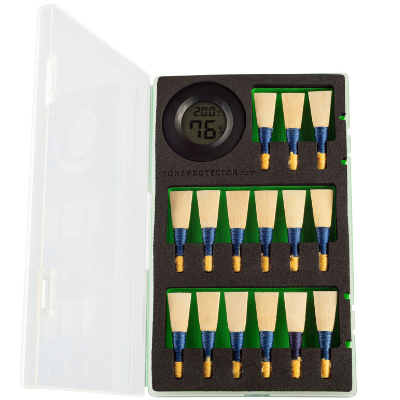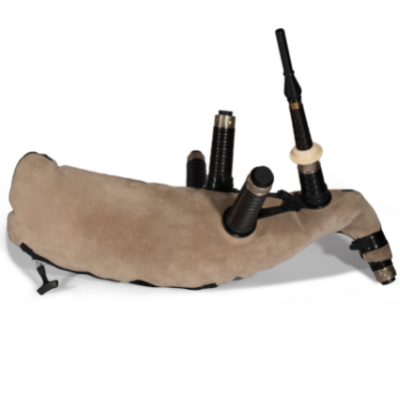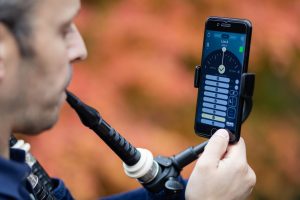Congratulations on your purchase of the Bagpipe Gauge — the best tool to learn to blow your pipes steady and strong.
I hope that you will join the thousands of pipers around the world who have experienced a steadier and more controlled sound by using the Bagpipe Gauge.
Steady bag pressure is the key to steady tone.
The Bagpipe Gauge is your best tool to learn how to maintain steady bag pressure. Pipers often refer to steady bag pressure as "steady blowing" — which is completely controlled by your arm. How you squeeze the bag with your arm determines the pressure. Blowing just serves to refill the air in the bag. Your arm should not alternately squeeze and release the bag, rather it should provide a constant steady force. Imagine a rubber band wrapped around the bag. As you blow into the bag, the band stretches as the bag inflates, but the band never stops squeezing. It keeps continuous pressure. This is what you want to do with your arm to maintain steady pressure in the bag. Indeed, your arm moves up and down because the volume of the bag is changing, but arm pressure must stay constant so the bag pressure is steady.
How do I attach my Bagpipe Gauge?
Your Bagpipe Gauge comes to you in three parts that are very simple to put together. Watch the video below to see how to do it.
IMPORTANT NOTE: the rubber stopper is sized to fit most makes of bagpipes. However, if the opening at the top of your drone is too big for the rubber stopper to fit snugly (i.e., stopper is too small), add a few wraps of electrical tape to make the stopper fit. Do NOT push the stopper all the way inside the drone top as it can fall in and be hard to remove.
1. Attach the clear plastic fitting to the brass-threaded connector on the gauge. Tighten it by hand as much as you can.
2. Attach the strap to the gauge. Turn the black tightener knob to get a good tight fit. You may cut off the excess plastic part that sticks out.
3. Attach the gauge to your blowpipe stock with the stretch rubber strap. IMPORTANT: Be GENTLE with the rubber strap. IT WILL BREAK IF YOU STRETCH TO HARD and FAST.
4. Plug the rubber stopper into the top of one of your tenor drones.
5. You may leave the drone reed in the drone. There's no need to remove the drone reed from that drone — unless the Bagpipe Gauge shows a reading of zero when you are playing. You can remove the reed or switch the stopper to a different drone and see if that one works with leaving the reed in.
How do I read the Bagpipe Gauge? The Bagpipe Gauge displays pressure in inches of water (in H2O).
How hard are my pipes?
• Very Easy: less than 25
• Easy: 25-28
• Easy Plus: 28-30
• Medium: 30-35
• Hard: more than 35 in/H20
How steady am I? Your fluctuations should be as small as possible . . .
• Keep Working: a range of more than 10 in/H2O
• Good: a range of +/- 10 in/H2O
• Very Good: a range of +/- 2-5 in/H2O
• World-Class: a range of +/- 0-2 in/H2O
The gauge perfectly reveals your bag pressure. Steady bag pressure is clearly shown on the bagpipe pressure gauge by a perfectly steady needle. As you play watch how much the needle moves as you play. Here's a general guide for steadiness as shown by the the needle.
What's the perfect pressure for my pipes?
A common question when using the Bagpipe Gauge is "What is the correct pressure to keep?" The answer depends on the strength of your chanter reed. Is the reed hard, medium, or easy? Every reed has an optimum pressure — a sweet spot — at which it produces the best tone, is the most efficient and stable. Here's how to find this optimum pressure. With your gauge plugged in, play High A. The High A should be full and bright, not crowy or scratchy. If it is a good reed you will hear some resonance or texture. If you decrease the pressure from the sweet spot the High A will get scratchy and eventually the reed will stop making a sound altogether. If you increase the pressure from the sweet spot, the High A will sound piercing and shrill. Find the sweet spot. That is the pressure you must maintain for every note on the scale. High A is the most pressure sensitive note on the scale, that's why you can use it to find the sweet spot, and that's why it defines the pressure for the reed overall.
How can I discover any bad habits and fix them?
As you play up and down the scale you may notice that you fluctuate your bag pressure depending on the note. This is normal. This is why you are using the Bagpipe Gauge — to identify these habits of unsteady pressure and to fix them and to create a new habit of steadier bag pressure. A common habit is to play a lower pressure on the bottom end of the scale and then blow harder for the top hand notes. In that case, you will need to train yourself to keep the same pressure on the bottom hand notes that you keep on the top hand notes. Or you may discover that your bag pressure unsteadiness shows up when playing difficult passages in your tunes. It may be difficult to change your habits, but with practice and the use of the gauge you can develop perfectly steady pressure. The world's best players who have achieved rock-steady tone all have learned to keep perfectly steady bag pressure. Once you've learned to do this, your chanter sound will be steadier and you will find it easier to fine tune the notes. Your drones will be easier to tune and they will stay in tune longer.
What other practice drills can I use with Bagpipe Gauge?
Note: pick a single note and play it for 30 seconds. Focus on keeping the same pressure whether you are blowing or not blowing. Also, watch for smooth transitions at the start and end of each breath — try to keep the pressure rock steady. If you get bored, try a different note. Use all of your senses. Listen to the sound of your pipes. Watch the Bagpipe Gauge. Feel your arm. Try to get locked into a solid, unwavering pressure.
The Slow Scale: start on Low G and play up the entire scale very slowly with three or four breaths per note. Focus on keeping the same pressure whether you are blowing or not blowing. Also, watch for smooth transitions at the start and end of each breath — try to keep the pressure rock steady.
The High A Scale: start on Low G and play up the entire scale very slowly alternating each note with High A, with three or four breaths per note. Focus on keeping the same pressure between each note and High A. Often, pipers tend to have a higher pressure on High A and then they drop the pressure on the lower note of the scale. Your goal is the same pressure on all notes!
A Simple, Slow Tune: try a simple, slow tune. What's the easiest tune you know? Try playing it at a very relaxed (i.e., slow) tempo and just focus on the gauge, and the feel of your arm locked on the bag. Try to keep the pressure solid.
Keep in mind that steady bag pressure is a skill that you will get better and better at with time and practice. It's an important part of learning to play the pipes, and it can be mastered by any piper regardless of age or experience level.
Where can I learn more?
Check out the BagpipeLessons.com Inner Circle for tons of premium, fully-interactive content! Membership gives you complete access to lessons and multi-media materials – stuff you won’t find anywhere else, including high-quality videos, mp3s, tunes, exercises, practice tips, and more! Sign up here for instant, complete access to all our lessons.
Good luck and please let me know how the gauge works for you! If you have had success with your gauge, send me a brief testimonial. I'd be happy to add it to the site.
Questions? Comments? Problems? If you have any questions, please feel free to email us at [email protected].
For more amazing products, please visit our online shop at BagpipeLessons.com/shop
Please visit the BagpipeLessons.com Facebook page to find more photos, tips, reviews and more!
Get products for your entire band! We're happy to offer band pricing of 15% off for orders of 10 or more (the discount will be automatically applied at checkout.)
Be sure to check out the BagpipeLessons.com Online Shop for more great tools to help you get the most out of your piping. We're the direct source for our exclusive products, including:
The Tone Protector™ — the world's first digital chanter cap with two-way humidity control.

The Tone Protector™ Reed Case — the best way to store your reeds for ultimate consistency and stability. Tune less and enjoy your reeds for 3-4x longer!

The Perfect Angle™ Blowpipe Positioner — maintain perfect posture and ergonomics with this innovative tool.
The Piper's Advantage™ Bagpipe Phone Mount — the world's first bagpipe phone mount for smartphones, tuners and metronomes.
The Piper’s Ultimate Reed Poker — save money and time with a special tool to bring your reeds back to life.
Good luck with your piping and please send a message if you have any questions.
Thanks!
Jori Chisholm
Founder of BagpipeLessons.com
Creator of the Tone Protector™
Piper's Advantage™ Bagpipe Phone Mount
The Piper’s Ultimate Reed Poker




